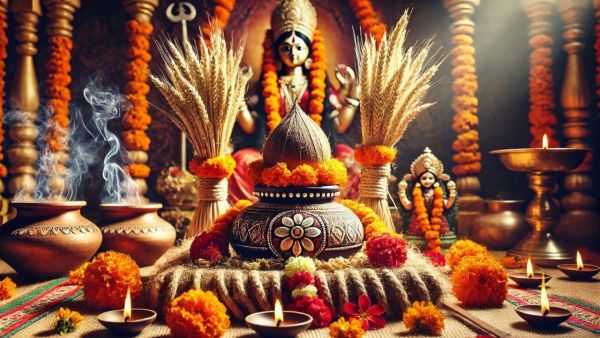
Mumbai: Navratri, one of the most significant Hindu festivals, is set to begin on October 3, 2024. During the nine days of Navratri, devotees worship the nine forms of Goddess Durga with devotion and traditional rituals. The festival starts with Ghat Sthapana on the first day, marking the invocation of the goddess. Devotees observe fasts, light an eternal flame (Akhand Jyot), and worship different forms of Durga each day to seek her blessings.
The first day is dedicated to Maa Shailputri, and worshipping her brings special blessings for success and prosperity. Here’s everything you need to know about Ghat Sthapana Vidhi, the timings, and how to perform the rituals correctly.
According to the Hindu calendar (Panchang), Navratri begins with the Pratipada Tithi of the Shukla Paksha (waxing phase of the moon) in the month of Ashwin.
Tithi Begins: October 3, 2024, at 12:18 AM
Tithi Ends: October 4, 2024, at 02:58 AM
Based on the rising tithi (Udaya Tithi), Navratri 2024 will officially commence on October 3, 2024.
Ghat Sthapana is the primary ritual performed on the first day of Navratri to invoke Goddess Durga. For 2024, there are two auspicious time slots for performing this ritual:
|
Timing |
Duration |
| Morning Muhurat | 6:15 AM to 7:22 AM (1 hour 6 minutes) |
| Abhijit Muhurat (Noon) | 11:46 AM to 12:33 PM (47 minutes) |
The Abhijit Muhurat during the day is considered especially auspicious for Ghat Sthapana.
Ghat Sthapana is an integral part of Navratri and must be performed following proper rituals to invoke the blessings of Maa Durga. Here is a step-by-step guide to performing the Ghat Sthapana:
Other Preparations
Invoke the Goddess
Daily Offerings
Note: It is advised to invite a knowledgeable priest for mantra recitations and detailed rituals.
On the first day of Navratri, devotees worship Maa Shailputri, the daughter of the mountain king (Himalayas). She symbolizes patience, compassion, and devotion. Maa Shailputri is revered for her dedication to Lord Shiva, whom she married after intense penance.
Her blessings are believed to remove all difficulties in life, especially for unmarried women seeking a suitable spouse and for married couples seeking happiness in their marital life.
Chant the following mantras while offering your prayers to Maa Shailputri:
Om Devi Shailputryai Namah
Hreem Shivayai Namah
Vande Vanchhitalabhaya Chandrardhakritashekharam, Vrisharudham Shooldharam Shailputrim Yashasvinim
By following these rituals and mantras with devotion, you can seek the blessings of Maa Shailputri, the embodiment of patience and power, to overcome obstacles in your life and lead a prosperous, peaceful life during this Navratri festival.